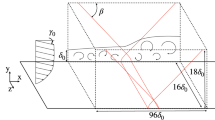Abstract
In this paper computational results for two different types of shock wave / turbulent boundary layer interaction flows are presented. It is shown that upstream effects of the shock induced separation cannot be reproduced by Wilcox's (1991) k-ω-model, whereas downstream of the interaction, predictions of pressure distribution and skin friction are acceptable. The inclusion of the compressible part of the dissipation rate and the pressure dilatation in the model has noticeable, but not dramatic effects on wall pressure and skin friction in the selected flow cases.
Similar content being viewed by others
References
Abid, R., Speziale, C.G. and Thangam, S.: 1991, ‘Application of a New k-τ Model to Near Wall Turbulent Flows’,AIAA paper 91-0614.
Baldwin, B.S. and Lomax, H.: 1978, ‘Thin Layer Approximation and Algebraic Model for Separated Turbulent Flows’,AIAA paper 78-0257.
Hannappel, R. and Friedrich, R.: 1992, ‘Interaction of Isotropic Turbulence with a Normal Shock Wave’,Fourth European Turbulence Conference, Delft, June 30 – July 3, 1992.
Mabey, D.G., Meier, H.U. and Sawyer, W.G.: 1974, ‘Experimental and theoretical studies of the boundary layer on a flat plate at Mach numbers from 2.5 to 4.5’,RAE TR 74127.
Murthy, V. S. and Rose, W.C.: 1978, ‘Wall Shear Stress Measurements in a Shock-Wave Boundary-Layer Interaction’,AIAA J. 16, 667–672.
Reda, D.C. and Murphy, J.D.: 1973, ‘Shock Wave/Turbulent Boundary Layer Interactions in Rectangular Channels’,AIAA J. 11, 139–140.
Rotman, D.: 1991, ‘Shock wave effects on a turbulent flow’,Phys. Fluids A 3, 1792–1806.
Sarkar, S., Erlebacher, G. and Hussaini, M.Y.: 1991, ‘Compressible Homogeneous Shear: Simulation and Modeling’,Eighth Symposium on Turbulent Shear Flows, Munich Sept. 9–11, 1991.
Selig, M.S., Andreopoulos, J., Muck, K.C., Dussauge, J.P. and Smits, A.J.: 1989, ‘Turbulence structure in a Shock Wave/Turbulent Boundary Layer Interaction’,AIAA J. 27, 862–869.
Settles, G.S., Fitzpatrick, T.J. and Bogdonoff, S.M.: 1979, ‘Detailed Study of Attached and Separated Compression Corner Flowfields in High Reynolds Number Supersonic Flow’,AIAA J. 17, 579–585.
Wilcox, D.C.: 1991, ‘Progress in Hypersonic Turbulence Modeling’,AIAA-paper 91-1785.
Zeman, O.: 1990, ‘Dilatational Dissipation: The Concept and Application in Modeling Compressible Mixing Layers’,Physics of Fluids A 2, 178–188.
Zhang, H.S., So, R.M.C., Speziale, C.G. and Lai, Y.G.: 1992, ‘A Near-Wall Two-Equation Model for Compressible Turbulent Flows’,AIAA paper 92-0442.
Author information
Authors and Affiliations
Rights and permissions
About this article
Cite this article
Haidinger, F.A., Friedrich, R. Computation of shock wave/turbulent boundary layer interactions using a two-equation model with compressibility corrections. Appl. Sci. Res. 51, 501–505 (1993). https://doi.org/10.1007/BF01082582
Issue Date:
DOI: https://doi.org/10.1007/BF01082582




